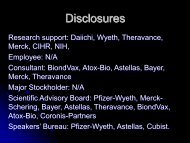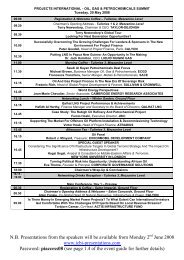VAP prevention â non-antimicrobial methods
VAP prevention â non-antimicrobial methods
VAP prevention â non-antimicrobial methods
Create successful ePaper yourself
Turn your PDF publications into a flip-book with our unique Google optimized e-Paper software.
Monday 6 th September 2010<br />
London<br />
<strong>VAP</strong> <strong>prevention</strong> – <strong>non</strong>-<strong>antimicrobial</strong> <strong>methods</strong><br />
Dr Duncan Wyncoll, Guy’s & St Thomas’ NHS<br />
Foundation Trust, London, UK<br />
Conflicts of Interest<br />
In the last 5 years I have acted as consultant,<br />
or received honoraria/research grants from:<br />
Abbott, AstraZeneca, Aqix, Bard, Bioproducts,<br />
ConvaTec, Cook, Covidien, Eli Lilly, Fresenius, GSK, Iskus<br />
Health, Kimberly-Clark, Pfizer, Sage, Takeda, Venner &<br />
Zassi
ICU acquired infections are common<br />
SOAP study. Crit Care Med 2006; 34: 344-53
1970 –<br />
1980’s<br />
<strong>VAP</strong> is an iatrogenic ‘syndrome’
Almost Universal Failure with HVLP Cuffs<br />
Photograph courtesy of Dr Peter Young
Pepsin – in the lungs!<br />
• Intra-tracheal pepsin used as marker for gastric<br />
aspiration in critically ill intubated patients<br />
• >6,000 tracheal aspirates (360 patients)<br />
• 89% of patients had pepsin detected at some<br />
stage<br />
• Aspiration was the most significant independent<br />
risk factor for pneumonia<br />
9/10 patients aspirate stomach contents<br />
Methany NA et al, Crit Care Med 2006; 34: 1007-15
PREVENTION STRATEGIES FOR <strong>VAP</strong><br />
Hand hygiene<br />
Avoid unnecessary antibiotics<br />
Shorten antibiotic courses<br />
Avoid ulcer prophylaxis<br />
Use sucralfate if required<br />
Closed circuit suctioning<br />
Chlorhexidine oral rinse<br />
Consider SDD<br />
Consider NIV<br />
Shorten duration of MV<br />
Semi-recumbent position<br />
Avoid circuit manipulation<br />
Avoid patient transportation<br />
Reduce accidental extubation<br />
Subglottic suctioning<br />
Optimize cuff design/pressure<br />
Coating the catheter<br />
PATHOGENESIS OF <strong>VAP</strong><br />
Bacterial Colonisation<br />
(oropharynx, stomach, sinuses)<br />
Aspiration of Contaminated<br />
Secretions<br />
(& ventilator circuit condensate/aerosol)<br />
<strong>VAP</strong><br />
The relationship between pathogenesis and <strong>prevention</strong> strategies for <strong>VAP</strong><br />
Modified from Kollef M, Crit Care Med 2004; 32: 1396-1405
Supine body position as a risk factor for nosocomial<br />
pneumonia in ventilated patients: a randomized trial.<br />
Drakulovic MB et al, Lancet 1999; 354: 1851-8<br />
%<br />
P=0.003<br />
P=0.018<br />
• n=86<br />
• Semi-recumbent vs.<br />
supine<br />
• Supine body position &<br />
enteral nutrition were<br />
independent risk factors<br />
for pneumonia
Feasibility and effects of the semirecumbent position to<br />
prevent <strong>VAP</strong>: a randomized study.<br />
van Nieuwenhoven CA et al, Crit Care Med 2006; 34: 396-402<br />
• Prospective multicentre<br />
trial of 221 patients<br />
• 45 o vs. 10 o<br />
NS<br />
NS<br />
• Target of 45 o not achieved<br />
85% of the time<br />
• On average achieved 28 o<br />
vs. 10 o
Benefits seen in ‘Drakulovic’ trial were not sustained…<br />
%<br />
Valencia M et al, Crit Care Med 2007; 35: 1543-9
Efficacy & safety of a paired sedation & ventilator weaning<br />
protocol for mechanically ventilated patients in ICU<br />
(Awakening & Breathing Controlled trial).<br />
Girard TD et al, Lancet 2008; 371: 126-34<br />
• 4 centres, 336 ventilated patients – ‘daily awakening & SBT’<br />
Intervention<br />
N=168<br />
Control<br />
N=168<br />
P Value<br />
Days w’out breathing assistance 14.7 11.6 0.02<br />
ICU LOS 9.1 12.9 0.01<br />
Hosp LOS 14.9 19.2 0.04<br />
Self extubation 16 6 0.031<br />
Reintubation after self-extub 5 3 NS<br />
• Interruption of sedatives & daily SBT reduces time on MV<br />
No reported effect on <strong>VAP</strong>, but if the patient isn’t intubated…
Oropharyngeal cleansing with 0.2% chlorhexidine for<br />
<strong>prevention</strong> of pneumonia in critically ill patients: a<br />
randomized trial.<br />
Panchabhai TS et al, Chest 2009; 135: 1150-6<br />
• CHX 0.2% vs. 0.1% potassium permanganate applied BD in<br />
471 patients<br />
0.2% CHX<br />
N=224<br />
Control<br />
N=247<br />
P Value<br />
<strong>VAP</strong> incidence 16 (7.1%) 19 (7.7%) NS<br />
Day of development of<br />
pneumonia (median)<br />
5 5 NS<br />
• No difference in any other outcome measured<br />
What about higher concentrations used more frequently…
Randomized controlled trial & meta-analysis of oral<br />
decontamination with 2% CHX for the <strong>prevention</strong> of <strong>VAP</strong>.<br />
Tantipong H et al, Infect Control Hosp Epidemiol 2008; 29: 131-6<br />
• CHX 2% applied QDS to teeth whilst intubated<br />
2% CHG<br />
N=102<br />
Control<br />
N=105<br />
P Value<br />
<strong>VAP</strong> incidence 5 12 0.08<br />
<strong>VAP</strong>/1000 vent days 7 21 0.04<br />
Irritation of oral mucosa 9.8% 0.9% 0.001<br />
• Combined results with other similar study<br />
• Relative risk for <strong>VAP</strong> 0.53 (0.31-0.9; p=0.02)<br />
Cheap intervention, 90% tolerance & its widely practiced…
Draft High Impact Intervention No 5 – 2010<br />
(Care bundle to reduce ventilation-associated pneumonia)<br />
3. Oral Hygiene<br />
• The mouth is cleaned with chlorhexidine<br />
gluconate (≥1-2% gel or liquid) 6 hourly<br />
• Teeth are brushed 12 hourly with standard<br />
toothpaste
Cuff Shape/Material & <strong>VAP</strong><br />
Coefficient of variation of<br />
cuff pressure<br />
PVC<br />
n=26<br />
CPU<br />
n=22<br />
TPU<br />
n=28<br />
P value<br />
82 ± 48 92 ± 47 135 ± 67 0.002<br />
Pepsin level, ng/ml 408 ± 282 217 ± 159 178 ± 126
Silver-coated ET tubes & <strong>VAP</strong>
Silver-coated ET tubes & <strong>VAP</strong><br />
Kollef MH et al, JAMA 2008; 300: 805-13
Silver-coated ET tubes & <strong>VAP</strong><br />
<strong>VAP</strong> @ anytime<br />
- Intubated ≥ 24 hrs<br />
<strong>VAP</strong> @ anytime<br />
- All Intubated<br />
<strong>VAP</strong> within 10 days<br />
of intubation<br />
- Intubated ≥ 24 hrs<br />
Silver tube<br />
Uncoated<br />
tube<br />
RRR %<br />
P value<br />
4.8% 7.5% 36 0.03<br />
3.8% 5.8% 34 0.04<br />
3.5% 6.7% 48 0.005<br />
<strong>VAP</strong> within 10 days<br />
of intubation<br />
- All Intubated<br />
2.8% 5.2% 46 0.007<br />
Kollef MH et al, JAMA 2008; 300: 805-13
Silver-coated ET tubes & <strong>VAP</strong><br />
(Microbiology)<br />
Silver tube<br />
Uncoated tube<br />
Staphylococcus Aureus 9 16<br />
MRSA 3 7<br />
Pseudomonas Aeruginosa 8 11<br />
Enterobacteriaceae 10 5<br />
Yeasts 5 7<br />
Streptococcus species 4 7<br />
Haemophilus Influenza 3 3<br />
Acinetobacter Baumannii 1 5<br />
Other 5 17<br />
Kollef MH et al, JAMA 2008; 300: 805-13
Pneumonia in intubated patients: role of respiratory<br />
airway care.<br />
Rello J et al, Am J Respir Crit Care Med 1996; 154: 111-5<br />
• 83 consecutive intubated patients undergoing continuous<br />
aspiration of subglottic secretions (CASS)<br />
• Failure of CASS (RR = 7.5, 95% CI = 1.5-38) & persistent<br />
intracuff pressure below 20 cm H 2 O (RR = 4.2, CI = 1.1-16)<br />
were factors independently associated with <strong>VAP</strong><br />
• Colonized subglottic secretions around the cuff are the<br />
most important risk factor for <strong>VAP</strong> in the 1 st 8 days of<br />
intubation<br />
• Study confirmed the importance of maintaining adequate<br />
cuff pressure & effective subglottic aspiration to prevent<br />
pneumonia
Automatic control of tracheal tube cuff pressure in<br />
ventilated patients in semirecumbent position.<br />
Valencia M et al, Crit Care Med 2007; 35: 1543-9
Subglottic Secretion Drainage Tubes
National Recommendations<br />
Year<br />
30 o Bed<br />
elevation<br />
Subglottic<br />
secretion<br />
drainage<br />
NICE (UK) 2008 Yes No Yes<br />
Brit Soc Antimicrob Chemotherapy 2008 Yes Yes No<br />
Scottish ICS 2008 Yes Yes Yes<br />
European HAP working group 2008 Yes Yes Yes<br />
Canadian Clinical Trials Group 2008 Yes Yes Yes<br />
Canadian Critical Care Society 2008 Yes Yes No<br />
American Assoc for Resp Care 2008 Yes Yes No<br />
IHI (US) 2006 Yes Yes No<br />
American Thoracic Society 2005 Yes Yes No<br />
American Assoc of Crit Care Nurses 2004 Yes Yes No<br />
CDC (US) 2003 Yes Yes No<br />
Oral<br />
CHX
Subglottic Secretion Drainage & <strong>VAP</strong><br />
Study n SSD (%<strong>VAP</strong>) Control (%<strong>VAP</strong>) p<br />
Mahul 1992 145 13 29 p
Subglottic Secretion Drainage Tubes<br />
• Are slightly stiffer & the cuffs are still not 100%<br />
effective<br />
• 48% failure rate – due to prolapse of mucosa into<br />
the suction port [Dragoumanis et al, 2007]<br />
• Design is improving rapidly; now 3 rd generation<br />
• Highly cost-effective<br />
• They don’t yet ‘eliminate’ <strong>VAP</strong>, but may be the<br />
most effective single <strong>non</strong>-<strong>antimicrobial</strong><br />
intervention
Kimberly-Clark<br />
£~15 ~£6<br />
~£10<br />
Covidien<br />
Taperguard<br />
Teleflex<br />
~£10<br />
Portex SACETT<br />
~£5<br />
Malinckrodt<br />
~£140<br />
~$90<br />
Bard Argento<br />
Young Lotrac
Nosocomial pneumonia risk & stress ulcer prophylaxis: a<br />
comparison of pantoprazole vs. ranitidine in<br />
cardiothoracic surgery patients.<br />
Miano TA et al, Chest 2009; 136: 440-7<br />
• SUP is associated with ↑ risk of <strong>VAP</strong><br />
• PPIs are linked to ↑ risk of CAP<br />
• Retrospective review of 824 patients receiving SUP<br />
PPI<br />
N=377<br />
H 2 RA<br />
N=457<br />
Nosocomial pneumonia 9.3% 1.5% 6.6 (2.9-14.9)<br />
OR<br />
• Multivariate logistic regression – pantoprazole was only<br />
factor +ve for pneumonia: OR 2.7 (1.1-6.7)<br />
SUP unlikely to have major effect on <strong>VAP</strong>, but some effect…
Stress ulcer prophylaxis & <strong>VAP</strong><br />
<strong>VAP</strong>/CDT<br />
Bleeding<br />
Limit prophylaxis to high-risk patients: e.g.<br />
• Acute kidney injury/acute hepatic failure<br />
• Patients with INR >1.5, or platelets
Early vs. late tracheostomy to prevent <strong>VAP</strong><br />
‣ Day 6-8 vs. Day<br />
13-15<br />
‣ [i.e. UK practice<br />
vs. US]<br />
Terragni PP et al, JAMA 2010; 303: 1483-7
The UK TracMan trial<br />
N=909 Early (Day1-4) Late (>10 days)<br />
30d mortality 30.8% 31.5%<br />
ICU LOS 13 13<br />
Hosp LOS 33 34<br />
Antibiotic use<br />
• Identical<br />
Sedation<br />
• Lower in early arm<br />
• Mean 6.9 vs. 9.3 days<br />
54% of ‘late’ arm (wait & see arm) never needed a<br />
tracheostomy!
Timing of <strong>VAP</strong> onset<br />
Number of patients with <strong>VAP</strong><br />
Average timing of<br />
tracheostomy in UK<br />
‣ 6-month<br />
study<br />
‣ 175 patients<br />
‣ <strong>VAP</strong> in 56<br />
Apostolopoulou E et al, Respir Care 2003; 48: 681-8
Tight glucose control to prevent <strong>VAP</strong><br />
Conventional ~ 8 mmol/L<br />
Intensive ~ 5.5 mmol/L<br />
NICE-SUGAR Investigators. NEJM 2009; 360: 1283-97
Tight glucose control to prevent <strong>VAP</strong><br />
NICE-SUGAR Investigators. NEJM 2009; 360: 1283-97
Tight glucose control to prevent <strong>VAP</strong><br />
NICE-SUGAR Investigators. NEJM 2009; 360: 1283-97
Selective Decontamination to prevent <strong>VAP</strong><br />
De Smet A et al, NEJM 2009; 360: 20-31
Selective Decontamination to prevent <strong>VAP</strong><br />
De Smet A et al, NEJM 2009; 360: 20-31
Reducing <strong>VAP</strong> – <strong>non</strong>-<strong>antimicrobial</strong> interventions<br />
Semirecumbency<br />
has limited effect<br />
Cuff pressure &<br />
shape is important<br />
Microaspiration<br />
is common<br />
CHG 2% seems to ↓<strong>VAP</strong><br />
Subglottic<br />
secretion drainage<br />
is reliably effective<br />
Early<br />
tracheostomy<br />
may ↓<strong>VAP</strong>, but<br />
not before day 7<br />
Stress ulcer<br />
prophylaxis has<br />
uncertain effect<br />
on <strong>VAP</strong><br />
But<br />
is best<br />
reserved for<br />
high-risk pts<br />
Application of<br />
common sense<br />
& technology








